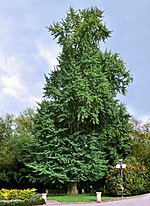The Paleocene (IPA: /ˈpæli.əsiːn, -i.oʊ-, ˈpeɪli-/ PAL-ee-ə-seen, -ee-oh-, PAY-lee-), or Palaeocene, is a geological epoch that lasted from about 66...
156 KB (17,582 words) - 08:31, 12 November 2024
The Paleocene–Eocene thermal maximum (PETM), alternatively ”Eocene thermal maximum 1 (ETM1)“ and formerly known as the "Initial Eocene" or “Late Paleocene...
170 KB (19,183 words) - 02:22, 6 November 2024
Dinosaur (redirect from Paleocene dinosaurs)
described it as evidence of Paleocene dinosaurs. The rock unit in which the bone was discovered has been dated to the early Paleocene epoch, approximately 64...
283 KB (28,268 words) - 03:57, 12 November 2024
The term Paleocene ammonites describes families or genera of Ammonoidea that may have survived the Cretaceous–Paleogene extinction event, which occurred...
8 KB (700 words) - 22:24, 2 August 2024
Titanoboa (category Paleocene lepidosaurs)
includes all boas and anacondas) snake that lived during the middle and late Paleocene. Titanoboa was first discovered in the early 2000s by the Smithsonian...
28 KB (3,195 words) - 01:24, 13 November 2024
Danian (redirect from Early Paleocene)
The Danian is the oldest age or lowest stage of the Paleocene Epoch or Series, of the Paleogene Period or System, and of the Cenozoic Era or Erathem....
14 KB (1,387 words) - 02:40, 29 October 2024
Thanetian (redirect from Late Paleocene)
Geologic timescale, the latest age or uppermost stratigraphic stage of the Paleocene Epoch or Series. It spans the time between 59.2 and 56 Ma. The Thanetian...
9 KB (794 words) - 19:55, 19 July 2024
Cretaceous–Paleogene extinction event (redirect from Cretaceous-Paleocene boundary)
temperatures in the early Paleocene. Approximately 46% of diatom species survived the transition from the Cretaceous to the Upper Paleocene, a significant turnover...
196 KB (21,550 words) - 14:25, 13 November 2024
during the early Cenozoic was warmer than today, particularly during the Paleocene–Eocene Thermal Maximum. However, the Eocene to Oligocene transition and...
36 KB (3,770 words) - 22:17, 8 November 2024
member and the largest living fish. A single extinct genus, Palaeorhincodon, is known from the Paleocene as well. "Rhincodontidae". Fossilworks. v t e...
1 KB (36 words) - 17:19, 2 April 2023
Insular India (section Paleocene fauna)
subcontinent. Across the latter stages of the Cretaceous and most of the Paleocene, following the breakup of Gondwana, the Indian subcontinent remained an...
26 KB (3,373 words) - 08:06, 30 May 2024
Placentalia (category Extant Paleocene first appearances)
around 90 mya, but the earliest undisputed fossils are from the early Paleocene, 66 mya, following the Cretaceous–Paleogene extinction event. The species...
23 KB (2,342 words) - 04:29, 14 November 2024
Selandian (redirect from Middle Paleocene)
the Paleocene. It spans the time between 61.6 and 59.2 Ma. It is preceded by the Danian and followed by the Thanetian. Sometimes[when?] the Paleocene is...
11 KB (977 words) - 23:04, 11 December 2023
placentals come from the early Paleocene, after the extinction of the non-avian dinosaurs. (Scientists identified an early Paleocene animal named Protungulatum...
222 KB (23,157 words) - 21:11, 12 November 2024
appeared during the epoch. The Eocene spans the time from the end of the Paleocene Epoch to the beginning of the Oligocene Epoch. The start of the Eocene...
107 KB (11,853 words) - 08:38, 12 November 2024
in North America during the Paleocene, they are also represented in Europe by the genus Jepsenella. Like most Paleocene mammals, the apatemyids were...
4 KB (356 words) - 07:33, 6 October 2024
with a widespread distribution in Europe and North America during the Paleocene. Mousebirds are slender greyish or brown birds with soft, hairlike body...
15 KB (1,465 words) - 12:48, 14 September 2024
Platform of the North American Plate ca. 56 million years ago in the late Paleocene. This collision caused subduction and volcanism in the Proto-Antillean...
29 KB (2,622 words) - 19:55, 6 November 2024
well developed) at birth. The rodent fossil record dates back to the Paleocene on the supercontinent of Laurasia. Rodents greatly diversified in the...
139 KB (14,367 words) - 22:58, 8 November 2024
(Cenomanian-Campanian) Genus †Aviturus Mongolia, Paleocene †Aviturus exsecratus Genus †Ulanurus Mongolia, Paleocene †Ulanurus fractus Genus †Zaissanurus Kazakhstan...
16 KB (1,594 words) - 04:15, 28 October 2024
F.A.; Polly, P.D.; Jaramillo, C.A. (2009). "Giant boid snake from the Paleocene neotropics reveals hotter past equatorial temperatures". Nature. 457 (7230):...
8 KB (708 words) - 18:01, 16 September 2024
Ginkgophyta declined in diversity as the Cretaceous progressed, and by the Paleocene, Ginkgo adiantoides was the only Ginkgo species left in the Northern Hemisphere...
67 KB (7,131 words) - 23:40, 4 November 2024
Purgatorius (category Paleocene genus extinctions)
Paleocene Bug Creek Group, along with leptictids. These deposits were once thought to be late Cretaceous, but it is now clear that they are Paleocene...
15 KB (1,572 words) - 22:07, 24 October 2024
0 Ma) Pliocene (2.59–5.33 Ma) Miocene (5.33–23.0 Ma) Paleogene (23.0–66.0 Ma) Oligocene (23.0–33.9 Ma) Eocene (33.9–56.0 Ma) Paleocene (56.0–66.0 Ma)...
69 KB (7,582 words) - 18:25, 11 November 2024
are the Permian–Triassic extinction event and the Paleocene–Eocene Thermal Maximum. The Paleocene–Eocene thermal maximum (PETM), alternatively ”Eocene...
51 KB (12,021 words) - 11:53, 22 October 2024
fossil perciform is the extinct serranid Paleoserranus from the Early Paleocene of Mexico, but potential records of "percoids" are known from the Maastrichtian...
11 KB (541 words) - 21:19, 21 December 2023
Antarctic interchange in the Paleogene. The other route was probably via Paleocene land bridges between South America and North America, which allowed for...
236 KB (23,527 words) - 03:53, 14 November 2024
order of extinct carnivorous placental mammals that lived from the early Paleocene to the late Miocene epochs in North America, Europe, Asia and Africa....
32 KB (3,434 words) - 04:38, 18 October 2024
Geological history of Earth (section Paleocene Epoch)
the Paleocene, Eocene and Oligocene Epochs. The Paleocene, lasted from 66 million years ago to 56 million years ago. In many ways, the Paleocene continued...
55 KB (6,434 words) - 06:34, 11 November 2024


























